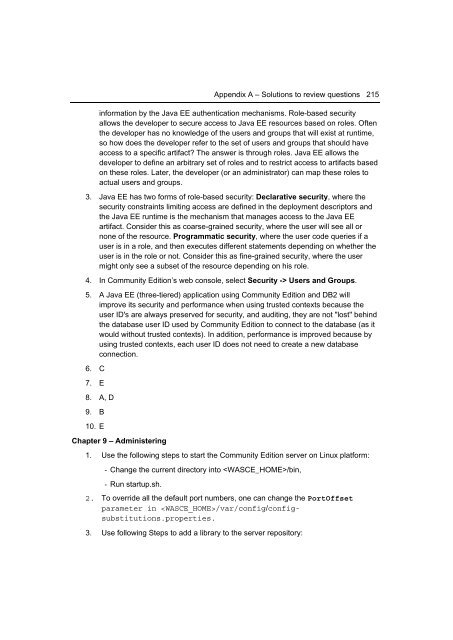Getting Started with WebSphere Application Server
You also want an ePaper? Increase the reach of your titles
YUMPU automatically turns print PDFs into web optimized ePapers that Google loves.
Appendix A – Solutions to review questions 215<br />
information by the Java EE authentication mechanisms. Role-based security<br />
allows the developer to secure access to Java EE resources based on roles. Often<br />
the developer has no knowledge of the users and groups that will exist at runtime,<br />
so how does the developer refer to the set of users and groups that should have<br />
access to a specific artifact? The answer is through roles. Java EE allows the<br />
developer to define an arbitrary set of roles and to restrict access to artifacts based<br />
on these roles. Later, the developer (or an administrator) can map these roles to<br />
actual users and groups.<br />
3. Java EE has two forms of role-based security: Declarative security, where the<br />
security constraints limiting access are defined in the deployment descriptors and<br />
the Java EE runtime is the mechanism that manages access to the Java EE<br />
artifact. Consider this as coarse-grained security, where the user will see all or<br />
none of the resource. Programmatic security, where the user code queries if a<br />
user is in a role, and then executes different statements depending on whether the<br />
user is in the role or not. Consider this as fine-grained security, where the user<br />
might only see a subset of the resource depending on his role.<br />
4. In Community Edition’s web console, select Security -> Users and Groups.<br />
5. A Java EE (three-tiered) application using Community Edition and DB2 will<br />
improve its security and performance when using trusted contexts because the<br />
user ID's are always preserved for security, and auditing, they are not "lost" behind<br />
the database user ID used by Community Edition to connect to the database (as it<br />
would <strong>with</strong>out trusted contexts). In addition, performance is improved because by<br />
using trusted contexts, each user ID does not need to create a new database<br />
connection.<br />
6. C<br />
7. E<br />
8. A, D<br />
9. B<br />
10. E<br />
Chapter 9 – Administering<br />
1. Use the following steps to start the Community Edition server on Linux platform:<br />
- Change the current directory into /bin,<br />
- Run startup.sh.<br />
2. To override all the default port numbers, one can change the PortOffset<br />
parameter in /var/config/configsubstitutions.properties.<br />
3. Use following Steps to add a library to the server repository:

















